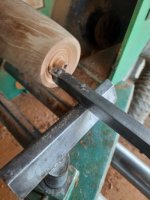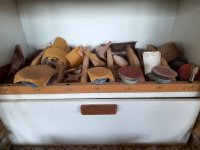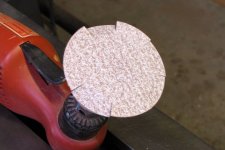Chas Jones
Member
- Messages
- 951
- Location
- Cotswolds, UK
 What tool do you like to use for hollowing out cups like this one?
What tool do you like to use for hollowing out cups like this one?Is this cherry the same as the cherry we have here in the U.S.? The species here is Prunus serotina.
Start off with Forstner bits then finish off in boring mode with home made Carbide tipped tools. (Stiff tool shafts essential for chatter control and decent handle for leverage)Very clean work as usual, Chas.What tool do you like to use for hollowing out cups like this one?


I always have a hard time sanding the inside of deep straight sided pieces like this and kind of give up on getting it "perfect" after the top couple of inches.




 The split stick sanding trick is a good one...I'll have to remember it. I have a similar square carbide boring bar. It's on a 24" hollow steel handle with a padded grip. I keep it about 1/2 full of lead shot for ballast and vibration damping.
The split stick sanding trick is a good one...I'll have to remember it. I have a similar square carbide boring bar. It's on a 24" hollow steel handle with a padded grip. I keep it about 1/2 full of lead shot for ballast and vibration damping.

One of the woods I use frequently is Paulownia... you have to start with 60 grit as no matter how sharp your tool, it has a fuzzy surface to start the sanding. It will sand out nicely, but you do work at it for a bit. I usually run up through at least 400.Nothing wrong with 80 grit in the appropriate circumstances, it's just a multi facetted cutting tool. I aim for 120 start but don't get paranoid if 80 has to be resorted to.
Doesn't do much for the longevity of you abrasives useful life though!
I use a sanding sealer after I get the wood smooth.... I usually power sand the lower grits with the lathe running so it doesn't take all that long to knock off the rough bits... when I get to the 120 I usually start hand sanding... with the lathe running.... I'll hand sand off the lathe between coats of the sanding sealer and my wipe on poly.Do you use a Sanding Sealer Chuck? a decently formulated sealer can stiffen any raised grain, seal/fill adjacent pores and act as an abrasive lubricant. I find it can considerably enhance abrasive cutting performance and speed of surface consolidation.
Also with soft and porous wood wet sanding with a sanding sealer can have similar effects to wet sanding with a polymerising oil as it fills open pores with sanding sludge.
Doesn't do much for the longevity of you abrasives useful life though!
